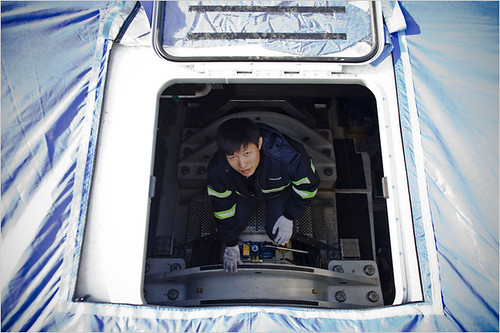
A factory that produces wind turbines in the People's Republic of China. The Chinese are far ahead of the United States in the development of clean energy technology., a photo by Pan-African News Wire File Photos on Flickr.
China's economy is on the rebound
Updated: 2012-07-09 07:58
By Dan Steinbock ( China Daily)
For two years now, the prophets of doom have forecast that China is heading for a hard landing. But while China is not immune to the debt crises in the West, it is better positioned to cope with them.
Last Thursday, the People's Bank of China lowered the benchmark deposit rates by 25 basis points and cut lending rates by 31 basis points; the second time in a month. The cuts fueled concerns that there is more trouble ahead for the Chinese economy.
In fact, there is a lot of noise in the markets and three macro trends complicate the picture. Economic conditions are deteriorating in Europe, the hoped-for recovery is slowing down in the United States, and China's economy has been weaker than anticipated in early spring.
But what we may be witnessing is a bottoming out.
At the recent euro summit, the region bought time, yet again. Last Thursday, the European Central Bank cut its interest rate to a historic low of 0.75 percent, and its overnight deposit rate from 0.25 percent to zero. However, these measures will not have an energizing effect on the eurozone, instead, they indicate that the ECB's ammunition is being exhausted.
In the US, job creation continues to slow, and unemployment remains at 8.2 percent. The number of unemployed Americans is 12.7 million and if the temporarily unemployed are included more than 23 million. Moreover, Washington has deferred critical economic decisions and a potential "fiscal cliff" until after the 2012 elections, even though the national debt is now close to $15.9 trillion.
No nation is immune to the paralysis of the transatlantic export markets, rising protectionism and slowing global growth. In India, growth sank to 5.3 percent, the slowest in nine years. During the first quarter of the year, China's economy grew about 8.1 percent year-on-year, the worst quarterly growth rate in three years.
In April, the Chinese economic data fell short of market expectations. In May, economic data were still weak, and the crisis in the eurozone entered a more dangerous phase. As a result, some investors became concerned that China would repeat the hard landing of 2008.
However, the Chinese economy has been recovering since the government's monetary loosening in fall 2011.
In the West, China is perceived amid a worsening slowdown. Economists do not see a return to the kind of massive 4 trillion yuan ($628 billion) stimulus package launched in fall 2008. Yet, signs abound that the government is employing a "stimulus lite" policy. Some plans were initiated in February, but the soft data in April accelerated measures on several fronts.
The National Development and Reform Commission has accelerated the approval process for major infrastructure projects, including new airports and subways. The central bank of China cut the reserve requirement ratio by 50 basis points; it is likely to be cut twice before the year-end, starting soon. As interest rate liberalization proceeds, a new rate cut cannot be excluded, if global prospects deteriorate significantly.
Fiscal policies are more proactive. The State Council has announced a 36.3 billion yuan subsidy program to encourage the consumption of energy-efficient household electronic appliances, automobiles, and power generators. The Ministry of Railways obtained large credit lines from banks in 2011, which will allow it to execute a planned investment of 400 billion yuan.
The Chongqing municipal government has signed multiple contracts with 30 major State-owned enterprises, which are expected to invest over 350 billion yuan in Chongqing in the next few years. This deal provides a blueprint for similar SOE-local government initiatives in the coming months.
Change is in the air, even if the markets have missed some of the signs.
Real GDP growth in China could rebound in the second half of the year, at about 8-8.4 percent year-on-year. Some key data remains soft, but there are signs of recovery in housing markets, exports, and lending. Industrial production is picking up and a series of financial reforms are being introduced.
At the turn of 2008/9, the world economy was still suffering from a severe downturn. When Premier Wen Jiabao said that China could achieve 8.5 percent growth in 2009, few observers in the West took his view seriously. In fact, the Chinese economy was already rebounding. Again, when Wen visited Wuhan in May, he said that the government was making stable economic growth an important priority.
In the past quarter, the government's focus has moved from fighting inflation to stabilizing growth.
However, there is nothing automatic about the rebound. It could erode, if further policy loosening is inadequate or too slow. Worldwide downside risks remain significant as the debt crises in the eurozone and the US are likely to deteriorate in the coming months. In China, monetary easing should solidify the rebound.
The "stimulus lite" is likely to support the rebound of inflation and property prices by the year-end. In that case, the window of policy loosening may prove relatively brief.
There is no room for complacency in the second half of 2012 and the beginning of 2013. China's economy has strong long-term growth potential. But the eurozone and even the US are moving toward a dangerous winter chill.
The author is research director of international business at India, China and America Institute, an independent think tank (USA), and visiting fellow at Shanghai Institutes for International Studies (China) and Singapore EU Center.
(China Daily 07/09/2012
No comments:
Post a Comment